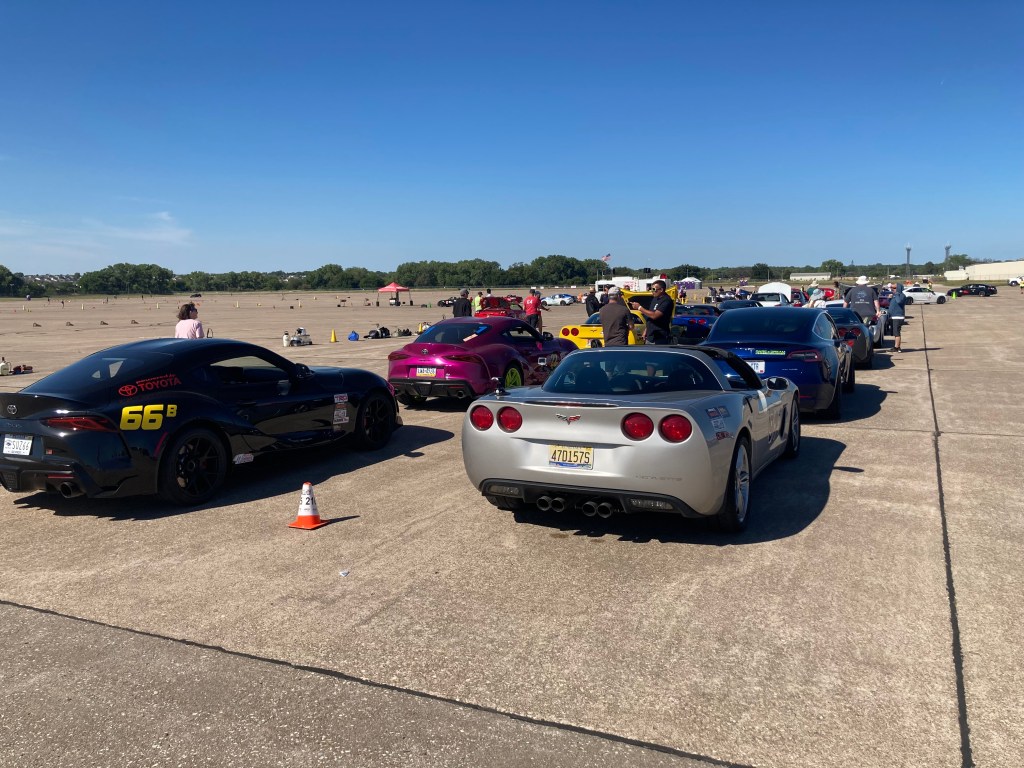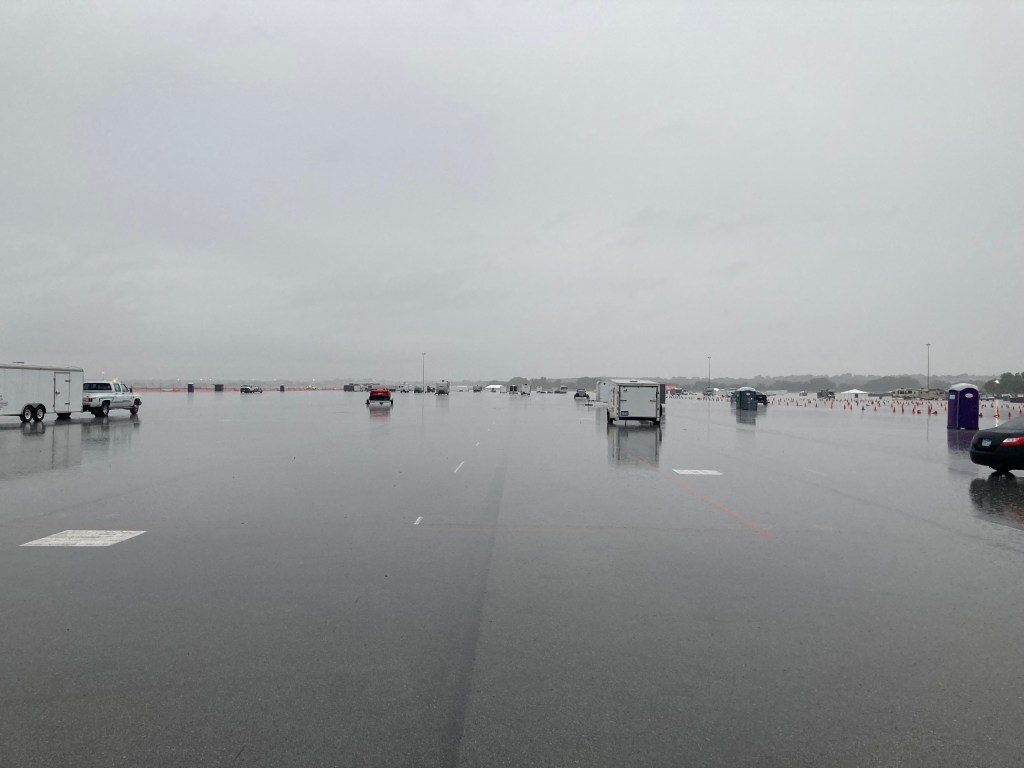Nats is well over and done with. I have mixed feelings about it and waited a while before starting to write this post. My results were, well, underwhelming. And well underwhelming, too.
Mental mistakes and driving errors forcibly reminded me that I’m still an amateur, which pisses me off after 12 years in this sport. I once heard the definition of an amateur to be someone who practices until they can do it right.
By contrast, a professional is someone who practices until they can no longer do it wrong.
We don’t get much practice in autocross. Most of us couldn’t afford the tires if we did. (Can you imagine the cost of doing a minimum of 4 hours of practice driving drills a day, 6 days a week, like you must do in any other sport to be good? Now you can understand why several of the best drivers in the sport are tire test engineers.) This means that you must make the most of each run you do get to really develop a disciplined, decisive and consistent driving style that eliminates big mistakes entirely.
That’s not me in autocross. At least not yet on courses as challenging as we had this year at Nats. But, I know what it should feel like. I’ve learned and taught another type of mental/physical endeavor and I remember that it was often difficult to properly demonstrate the wrong way to do things for the students even when it was called for.
Here’s the summary: 1) I was the 2nd fastest B-Street car in the Pro-Solo Finale. (I wish I knew how to put the accent above the “e” in the WordPress editor. Sorry.) That result also gave me 2nd place in the years’ points championship for BS, which was good for a trophy. I admit that a lot of it was luck, plus a smaller than usual number of competitors in BS this year, but I’ll politely take it. The car was great, just like it had been the entire second half of the year once we figured out set-up and pressures.
2) I was 9th of 19 drivers in BS Solo, the SCCA trademarked name for autocross. No trophy and none deserved. Both the car and the driver were terrible. Very lucky not to be at the bottom.
How can the same car on the same tires at the same site be great in one event and terrible a few days later?
For one thing it wasn’t the same site. More on that later. For another thing, don’t ever underestimate the bad effects from a lack of disciplined driving. It’s really so very easy to give up time in big chunks.
The Pro-Solo, which always occurs the weekend before Solo Nationals, is an event for which you must qualify by garnering good results in at least two events during the year, plus there’s an attendance cap set at 275 total competitors spanning all the classes. (Actually only 266 drivers had times this year.) As a result, the surface gradually rubbered-in nicely over the course of two days of competition and the moderate temperatures meant the gap sealant between the concrete slabs largely stayed put in the gaps. I used the wet skidpad to clean the tires after each four-run session, but the grip stayed consistent (or got better as heat built in the tires) during the four runs of each of three sessions. During the last session I was finally able to restrain my over-driving for one run on each side and avoid major mistakes. The other 10 runs of the total 12 were real garbage from poor reaction times to slow 60-foot times, on into mistake-riddled course driving, all caused by emotional, out-of-control over-driving. What a jerk!
So, I squeaked by with an OK result, though way off the winning pace. A real Pro would have done the opposite of me: 10 good runs and (maybe) 2 poor ones. That’s what the BS Pro-Solo Finale winner, Geoffrey Wolpert, appears to have done. (I don’t know how he actually felt about his runs.) Maybe a really top driver, say, an SCCA Driver of Eminence, might have 10 good runs and 2 great ones. (Not that Geoff isn’t a top driver!) I got to interview one of that species, Bartek Borowski, as part of my reporting duties for Sportscar magazine, after he won his 10th National Championship in ES this year. I think I learned something just by talking to him for a moment. About his third run on Day 1 that put him in the lead he said, “Finally under control.” All three runs that day looked perfect and under control to me!
For the Solo competition held during the following four days there were approximately 1100 competitors on the same piece of concrete, half competing the first two days and half the second two days, with, perhaps crucially, much warmer temperatures. My co-driver (who hadn’t driven an autocross in over a month due to requirements of his work) and I ran the last two days. They sweep the surface with a machine each evening, so big chunks of accumulated rubber were never a problem.
What was the problem? I put it into a mock formula: OPR (Other People’s Rubber) + crack sealant + wrong tire type + >80 degrees F = grip that gets worse during each run and from one run to another as a film of rubber mixed with sticky crack sealant accumulates in an ever-thickening layer on the hot tire surfaces as the run progresses.
Even though we had a team of friends helping to jack up the car after every run and remove this layer from the tires with oscillating tool cutters, good grip would only last for the first 1/3rd of each run. By the last third both lateral and longitudinal grip were down nearly 10%. I was unable to mentally adapt to this change and consistently braked too late on corner entry and ran wide at least twice during the 2nd half of each run. The upshot was that I was both slow and hit cones on two of the three runs each day. This was very abnormal for me. I just don’t hit very many cones. Usually.
One of our volunteer tire cutters was also working a competitor’s tires, which were a different brand. (I wanted and tried to obtain that brand, but failed due to shortages.) That car accumulated barely anything, perhaps because of a different rubber compound and perhaps partially because those tires need to be hit with water after each run while my tires need to get quite warm for best grip. So, we used no water. (In retrospect it may have been better if we had watered our tires after each run and kept them as cold as possible, but I can’t be sure how much that would’ve helped. We’d had no way to test for that during the year.)

After Day 1 we knew that for Day 2 we had to be fast, clean and tight on the first run as that would be the only run with anything like the good grip we were accustomed to receive from the car. I was able to get a clean first run, though far from mistake-free. It was just enough to retain a mid-pack position. Unfortunately, my co-driver coned his first two runs, so he had to be super careful on the last one just to take 18th and avoid last place.
I’m anxious to do a lot more events this Fall. Much to work on.
A Word On The Competitiveness of the C6 Base in BS
Several people, both in person at Nationals and other events during the year and on-line, have asked me what I think about the competitiveness of the C6 Base in B-Street. Some of these inquiries came from people not presently in the class but considering joining. I’ve thought some on this question and now have an opinion.
I can say without reservation that in every national and local event I’ve competed in this year, whether it was on asphalt or concrete, with the possible exception of Solo Nationals itself due to the specific course designs and local conditions that were outliers compared with all other courses/events I’ve driven this year, the performance of the C6, the M2, M2C and M3, and the early and late Supra were exactly commensurate with the performance of the driver at that particular event. As far as I can determine, the driver that drove the best on that day won every time. These six cars are very, very close in performance, given the present tire technology and the various strengths and limitations inherent to each car. I just don’t think there’s a lot of course dependency, either. So, at least for this year and next, if you are in a C6 and you drive best you will win.
I would also say that I doubt this situation will remain static for very long. The M2 and Supra in particular are being improved basically each model year, while the C6 will always be what it is. (And I like what it is very much!) Both the M2 and Supra, significantly underrated in power by their manufacturer(1) from the start, now have considerably increased power compared to their initial configurations and with no end in sight. I think that wheel width and tire technology limitations are what keep the C6 competitive for now.
The C6 Base accelerates in a straight line in 2nd gear just as fast as the C6Z06, given equal rear tire diameters, until it runs out of RPM. Both the M2C and the later Supra accelerate significantly faster. But what counts most in regard to power in autocross is how fast you can accelerate beyond the apex of a slow corner, which is a very different and much more complex thing. If either the M2 or Supra got even a half-inch increase in rear rim width the C6 would then be at a significant disadvantage, I believe.
The manual transmission version of the Supra coming out in model year 2023 along with certain suspension improvements intended to make it drive better at the limit may vault it to the top of the class. It could be a class killer. Right up until a newer M2 out-paces it! As one Street Activity Committee member remarked, “B-Street is the wild west!”
(1) I have no idea how BMW is accomplishing this, legally. They have obviously found a loop-hole in the European regulations, whereas the Corvette LS3 engine met the newer SAE standard that required any randomly chosen engine to dyno test within +/-1% of the rated power level under strictly controlled conditions. That Chevrolet was confident they could meet this voluntary standard is a testament to the precision and consistency reached by their V8 engine design, part manufacturing and assembly processes at that time. BTW, the LS7 motor in the C6Z06, when it first came out, was not submitted for certification to this standard.





